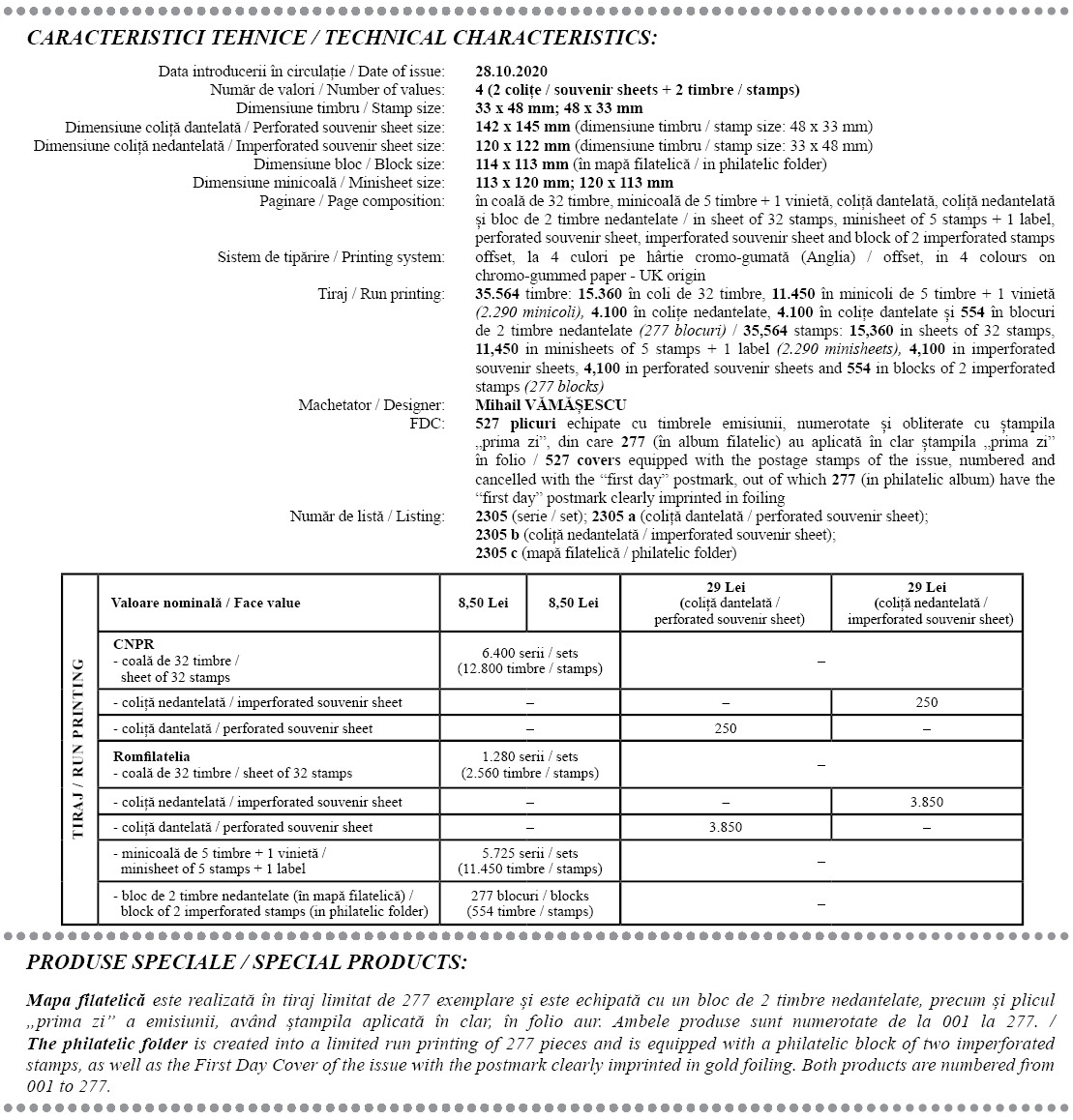 On the 100th anniversary of the signature of the Peace Treaties of Paris, on Wednesday, October 28, 2020, Romfilatelia introduces into circulation a postage stamps issue with the thematic title The Peace Treaties of Paris, 1919–1920.
On the 100th anniversary of the signature of the Peace Treaties of Paris, on Wednesday, October 28, 2020, Romfilatelia introduces into circulation a postage stamps issue with the thematic title The Peace Treaties of Paris, 1919–1920.
The achievement of Romania’s national unity acquired international recognition through Saint-Germain-en-Laye Treaty with Austria – attesting the union of Bukovina with Romania (September 10, 1919), Trianon Treaty with Hungary – attesting the union of Transylvania and Banat with Romania (June 4, 1920) and the Peace Treaty of Paris by which the main allied powers expressly accepted the union of Bessarabia with Romania (October 28, 1920).
Trianon Treaty belongs to the series of international documents concluded at the end of World War I besides the peace treaties signed between the Entente forces and Germany (Versailles, June 28, 1919), Austria (Saint-Germain-en-Laye, September 10, 1919), Bulgaria (Neuilly, November 27, 1919) and Turkey (Sčvres, signed on August 10, 1920 and replaced by Lausanne Treaty of July 24, 1923).
Trianon Treaty includes the Covenant of the League of Nations (a common content for all peace treaties concluded after the World War I) and defines Hungary’s borders with the neighbouring states – in principle its current borders. It approved the inclusion of the Croatian and Slovenian territories, of Vojvodina and of the western part of the former province of Banat into the Kingdom of Serbians, Croatians and Slovenians, the inclusion of Slovakia and Ruthenia (currently in Ukraine) into Czechoslovakia, of Transylvania and of the eastern part of Banat into Romania, and of Burgenland into the Republic of Austria.
An important role in tracing the Romanian borders at the Peace Conference was held by Emmanuel de Martonne, a French scholar from the University of Sorbonne who had written in his youth a doctoral thesis on the geographical distribution of population within the Romanian Kingdom. During the proceedings of the Conference he brought arguments for the use of border viability principle recommending that the new borders should not only take into account the ethnic configuration but also the landscape and the territorial infrastructure. The thoroughness of Emmanuel de Martonne’s work is proven by the fact that one century after the Trianon Treaty the borders between Romania, Hungary and Serbia have been kept as he drew them.
The treaty was signed on June 4, 1920, in the Great Trianon Palace of Versailles. The high officials that signed this historical document represented France, the Great Britain, Italy, the United States, Japan, Romania, the Kingdom of Serbians, Croatians and Slovenians, Czechoslovakia and other nine countries among which Hungary represented by Ágost Benárd and Alfréd Drasche–Lázár. From the Romanian part, the Treaty was signed by Dr. Ion Cantacuzino, state minister, and Nicolae Titulescu, minister of finance and the first delegate to the Peace Conference.
In the last phase of the Peace Conference of Paris they elaborated the provisions of the Peace Treaty of Paris recognising the historical vote of Country Council of Chisinau (March 27, 1918) and, consequently, the act of union of Bessarabia with Romania. The Contracting parties were the Great Britain, France, Italy and Japan, on one hand, and Romania, on the other hand. Signed on October 28, 1920, the treaty stipulated that the “High contracting parties declare that they recognize Romania’s sovereignty over the Bessarabian territory spreading within the current border of Romania, the Black Sea, Dniester River, from the mouth thereof up to the point where it is cut by the former border between Bukovina and Bessarabia, and this former border.”
As for the Romanian part, the treaty was signed by Take Ionescu, the minister of foreign affairs, and Dimitrie I. Ghica, the head of Romanian Legation in France.
The treaties signed during the Peace Conference of Paris (1919-1920) internationally recognized the new frontiers of the Romanian state thus inaugurating a historical period known as the Greater Romania or the Reunited Romania.
The postage stamps issue is made up of two stamps and two souvenir sheets.
The first postage stamp of the series having the face value of Lei 8.50 reproduces Nicolae Titulescu’s portrait, a signatory of Trianon Treaty, and the perforated souvenir sheet containing the stamp with the face value of Lei 29 consists in a graphic ensemble where the Palace of Trianon is put next to Romania map made by Emmanuel de Martonne and reproduced in the Parisian publication “Le Petit Journal”. The stamp of the perforated souvenir sheet reproduces the portraits of Ferdinand I and Queen Marie next to the coat of arms of Greater Romania. Within the space of the perforated souvenir sheet one may see the portraits of the Romanian personalities present at the proceedings of the Peace Conference, namely Ion. I. C. Bratianu, Nicolae Titulescu, and Dr. Ion Cantacuzino.
The second postage stamp having the face value of Lei 8.50 reproduces the portrait of the head of Bessarabian delegation at the Peace Conference of Paris, Ion Pelivan, and the stamp of the imperforated souvenir sheet having the face value of Lei 29 reproduces Take Ionescu’s portrait, in a graphic ensemble with the Act of Union of Bessarabia with Romania bearing the date of March 27, 1918.
Romfilatelia would like to thank the Diplomatic Archives of the Romanian Ministry of Foreign Affairs and the Romanian Academy Library for their documentary and photographic support granted in the achievement of this postage stamps issue. We also appreciate the support given by Dr. George Damian from the European Studies Centre for Ethnical Issues of the Romanian Academy.



